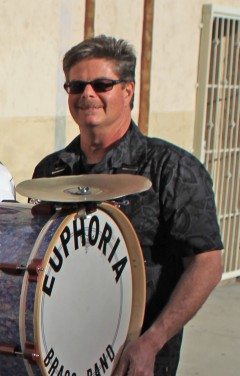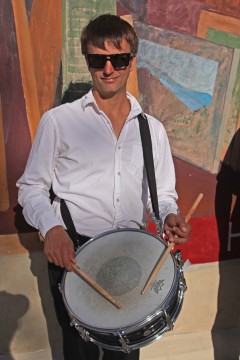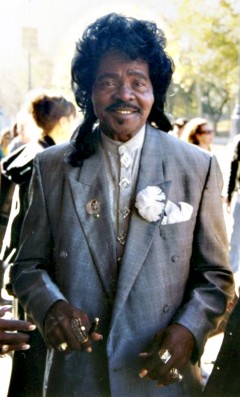Cover Story
Euphoria Brass Band: Puttin’ Out the Fat and Sassy Sound

Left to right: April West, Drew Miller, Ron Bocian, Steve Ebner, J.P. Balmat, David Jackson, Wayne Rice. Photo: Dan Chusid

Drew Miller. Photo by Dan Chusid.

Ron Bocian. Photo by Dan Chusid.

Ernie K-Doe
In his landmark documentary series of the ’70s, America, British journalist Alistair Cooke made the astute observation that had Thomas Jefferson not sold the French on his savvy real estate transaction called the Louisiana Purchase, New Orleans — not Washington D.C. — might had become the national capital of this continent.
And for those who are concerned over what little progress is being made by both major parties these days in the city along the Potomac, the idea of politicians running freely amok in the Bohemian headquarters of the true South conjures up images reserved for three a.m. nightmares.
Ahh, New Orleans. Who leaves this port not seduced by the music of jazz, blues, and the occasional French Zydeco number? And when you complete the journey with the gastronomical delights of shrimp, crawfish, jambalaya, and gumbo (save room for the mint julep dessert), you are transformed. Such an experience occurred for San Diego percussionist Drew Miller, who regularly keeps the beat on his bass drum for the San Diego-based but heavily New Orleans-influenced group, the Euphoria Brass Band, who have just released their energetic debut album, Coast to Coast. Miller’s New Orleans transformation struck him back in 1996 when he visited the city with his wife and her family. “ I was immediately enamored with the time-honored familial music traditions. The brass band tradition really resonated with me.” said Miller. “I think for most people who are not from Louisiana or who have not yet visited, it’s hard to really understand the incredible power and supreme funkiness of a “NOLA” brass band. Most people — until they get down there and witness a brass band rolling down the street or in a club — they just don’t get it. When witnessed for the first time in person, it can be somewhat of a life-changing experience. Most of us, when we think of brass bands, we tend to think of high school and college football games. While these bands are chock full of talent, they tend to lack a special, rather elusive factor… that New Orleans “second line” drum groove. A certain syncopation, that’s where the funk comes from. That’s what makes your feet wanna move and your booty shake!”
Miller describes it as a beat “not easily replicated by non-New Orleanian musicians. It is something that comes with hearing and feeling it all your life. Perhaps in my case, since I have been an absolute freak for many styles of New Orleans music ever since my first trip there, I have absorbed it into my being.”
The history of the brass band is a multi-cultural pursuit. One element of the sound was influenced by the rich melody of European style-horn bands. Another link is the strict, no-nonsense military marching band music, which is why John Phillip Sousa remains a larger-than-life figure every July 4th. But the final — and most important element — is the African folk music tradition, which is really at the heart of all the music associated with New Orleans. During the 1970s, the stereotype of a street band playing “When the Saints Go Marching In” for the umpteenth time to tourists was eclipsed by a musical sun; brass bands became hip. Miller explained why.
“Interestingly, the way I understand it, the long-standing brass band tradition was in a slump in the ’60s. This music tradition and culture really got up and was thriving during the reconstruction era of the United States. We’re talking 1870s. Like anything else it changed and adapted with the times. I suspect back in its infancy (post Civil War), it leaned toward a heavy militaristic sound. Then as the Jazz Age come into being, the brass bands incorporated a “ragged” feel to their playing and of course their repertoire changed as well. From the early 1900s through the 1950s brass bands proliferated in New Orleans and jazz was king. Social Aid and Pleasure Clubs with their jazz funerals for members who passed away and Second Line Parades really kept the brass bands busy. But in the ’60s the tradition faltered in that the young were not embracing the music and culture as they did before. Enter world class New Orleans-born jazz guitarist Danny Barker, who sees a need to rekindle the fire in the youth of New Orleans. He starts the Fairview Baptist Church Marching Band and he ignites a brass band renaissance. From this springs, most notably, the Hurricane Brass Band and the Dirty Dozen Brass Band. Made up of young hip kids, they infuse the old time honored sound with the latest music of the day: contemporary jazz, R&B and then funk.
“This new version begins to catch on like wildfire, which in turn spurs other bands to form,” said Miller. “So each decade, as the popular music of the day gets infused in this street tradition, the sound and feel changes a bit. As we move into the latter part of the 20th century bands like Rebirth Brass Band and Soul Rebels begin to let their music be informed by Hip-Hop and Rap. Those bands, as well as Stooges, Hot 8, and most recently, TBC, Baby Boyz, Young Pin Stripe and Young Fellaz are moving it forward yet again. Exciting for sure, as we witness a living, breathing, ever-changing tradition thrive and flourish. These new young musicians are the ‘keepers of the flame,’ making sure this important music and culture keep moving ever forward.”
The Euphoria Brass Band is making its own sizable contribution keeping the tradition alive, judging by the favorable crowd reaction to their sets at last month’s Gator by the Bay Festival at San Diego’s Spanish Landing. Another way Miller is promoting his musical cause is through a Saturday night radio show. “In 2000 I began as a DJ at KSDS Jazz 88.3 FM. A longtime friend, Michael Bourdet, had been on air for some time at Jazz 88 and one day I asked him about the possibility of getting a shift there. Michael made it happen! I have a big love for jazz so it was a wonderful opportunity for me. After two years as an on-air personality with a jazz show that aired Mondays mid day, I approached our Program Director at the time, Joe Kocherhans, about the possibility of creating a specialty show focusing on the music of New Orleans. Well, I knew Joe has a big love for NOLA like I do and he quickly gave me the thumbs up. I had one stipulation: I had to be able to play all of the many wonderful styles that make New Orleans music what it is: a big musical gumbo. I got the go ahead to not be limited to just jazz, but also showcase blues, brass band, Mardi Gras Indian, R&B of the ’50s and ’60s, funk and a little Cajun and Zydeco for spice. I quickly came up with a name for the show that I felt said it all: ‘Second Line Parade.’ I am proud to say we are heading into our 11th year of the show.”
Whether performing near San Diego Harbor or leading the audience marching through Normal Heights’ Adams Avenue in a Big Easy take on the Pied Piper of Hamelin, the Euphoria Brass Band bring it up a few notches in live performance. It is also a pleasure to report that the live spirit still comes through on their new studio recording, thanks to the assistance provided by Mike Hogan of Necromancer Digital Studio. How was the live sound pulled off ? “That (live element) is most definitely what we wanted to achieve,” explained Ron Bocian, the band’s snare drummer. “That is how it was recorded…we’d roll it off and let it rip! We had a very fortunate opportunity to record at Hiroyuki Ikezi’s studio in Rancho Santa Fe. He attended one of our concerts at Dizzy’s and is quite the jazz fan, so with EBB he got a nice taste of that New Orleans early jazz vibe and offered to record us. It was divine timing because David Bandrowski (banjo, guitar) was getting set to return to NOLA and we definitely wanted to capture the material that we’d written and performed all summer. We only had two nights to get what we could. Hiro was due in surgery the following week and was to be incapacitated for several months after. We got in under the gun…or knife in this case! (laughs). The two sessions were smooth. We captured 14 tunes in total: ‘Blues for Wayne,’ ‘The Homecoming Song,’ ‘Who Took the Happiness Out’ were all done in one take.”
The only hint of melancholy on the otherwise joyous sounds of Coast to Coast is the realization that Bandrowski is no longer strumming in San Diego on a daily basis. “I had been in San Diego for some time before I made the connection with Dave,” said Bocian. “He lived across the street from me in NOLA in the Garden District. I used to see him dragging his banjos around and we’d wave at each other. But when I found out he was in San Diego, it was kind of like my lifeline connection to New Orleans. We immediately became close allies and [are] now good friends. I am working on a tune with him for EBB right now. I can speak to him about what I am hearing rhythmically in relation to something very distinct in New Orleans, perhaps some Mardi Gras Indian chant or Meters melody, and he can nail that sound instantly without thinking.
“I believe a large part of why Dave would leave the beautiful environs of San Diego is for that same direct connection to the source of so much of his musical inspiration. The song ‘Do You Know What It Means to Miss New Orleans?’ is a hard one to appreciate unless you have really bathed in the music and culture of that great city. I am hoping he figures out how to hang with us in San Diego while everyone in New Orleans is melting from the heat from June ’til October.”
Prior to relocating to San Diego, in the aftermath of Hurricane Katrina, Bocian performed in New Orleans with such disparate musical acts as Ernie K-Doe (1936-2001) and Alex Chilton. K-Doe’s signature hit was 1961’s “Mother-in-Law,” a popular recording that was covered later by many bands, most notably Herman’s Hermits during the British Invasion. Memphis-born Chilton was a teen prodigy who sang the lead vocal on the Box Tops’ “The Letter” in 1967 before forming college radio heroes Big Star in the ’70s. His eclectic musical tastes led him to the adventuresome New Orleans musical scene and his untimely death in 2010 (the Troubadour published an appreciation piece in the March 2010 issue) left a void in the independent music world. “I was a longtime member of New Orleans local faves Egg Yolk Jubilee. Somehow it was proposed that Egg Yolk Jubilee would be Ernie’s backing band,” said Bocian. “ I believe New Orleans legends Quintron and Miss Pussycat were responsible. We were also frequent patrons of Ernie’s Mother-In-Law Lounge on Claiborne in New Orleans, named after his hit song “Mother-In-Law.” At the time his mother-in-law actually lived upstairs over the bar. She would come down in her night gown while we were rehearsing with Ernie. I remember thinking that it must be awful for her to hear his song… the first line is ‘the worst person I know’… Mother In Law.’ I don’t think she cared. Ernie was simply an electrifying performer; his outfits were epic, his wigs were dazzling, his moves were unbeatable, his voice was perfectly seasoned. He would direct the rehearsals with humor and fire — screaming at the guitarist to take off that fuzz (referring to distortion), saying things like ‘What are we — in outer space?!,’ ordering the horns to clip those notes tighter. If I was grooving some fill on the drums, he’d yell, ‘Just keep pecking away on the sock cymbal, drummer!’ I didn’t know what a sock cymbal was at the time. And, of course, we did EXACTLY what this man asked us. We all revered the lineage he was coming from: Cosimo Matassa, Allen Toussaint, all the great New Orleans R&B artists. The whole experience of living in New Orleans was for me the best musical education I could imagine!”
Bocian recalled Chilton being “amazing. My first gig was [when] he asked all my numbers — birth date, time etc. — he was a numerology guy…so after he got my birth date he basically had me figured out. I was pestering him to go over the material we’d be performing to this packed house and he very coyly declined to divulge what he’d choose to perform. Exacerbated, I started rattling off tunes of his that I knew. That quickly annoyed him and made it much worse. He then ordered a Diet Coke with lemon and changed the subject. I tried to hide my anxiety, which I think he appreciated, and after a few minutes of perspiration he said with a guru-like voice, ‘You’ll be fine.’ He wanted to keep it fresh, straight from the heart and bypass the thinking mind. I really only played only a handful of gigs with him, one of which was a wedding, which was more like an appearance. He sat in with my former band. He really loved to perform the old New Orleans R&B.”
For all of the Euphoria Brass Band’s fixation on New Orleans, there’s a strong local connection with the group. Half of the band members were actually born in San Diego (Miller moved here as a child); saxophonist David Jackson, saxophonist-clarinetist J.P. Balmant, and Miller all attended Mission Bay High, with Balmant returning to his alma mater to direct the school music program. Trumpeter Steve Ebner is a graduate of Pt. Loma High and Sousaphonist Wayne Rice attended Poway High. Two inference points should be made; first, San Diego is not the “rootless” metropolitan area it is perceived to be; and second, music does matter in public schools.
It should also be noted that the Euphoria Brass Band is not exclusively an all-male group. Transplanted Midwesterner April West (trombonist) joined the band with an impressive resume including teaming up with local boogie-woogie piano queen Sue Palmer.
Coast to Coast’s 12 tracks are divided up by group originals, fine interpretations of covers and traditional New Orleans fare. Balmant composed the title track, which kicks off the CD and wrote the equally rousing “Lurch” and “Slippin.” Rice is responsible for “Blues for Wayne,” and Bandrowski spotlights his guitar picking on “Footies Blues.” Inspired cover versions include the Dirty Dozen Brass Band’s “Blackbird Special” and South African pianist Abdullah Ibrahim’s “The Homecoming Son.” There are two traditional New Orleans Dixieland songs, the type of toe-tappers that would go over well at the annual Thanksgiving Dixieland Festival in Mission Valley: “Whoopin’ Blues” and the spiritual, “Just a Closer Walk With Thee.” The latter composition is a favorite at jazz funerals. At first viewed as blasphemous by upper-crust New Orleans society, the attempt to add swing time to gospel melodies is now generally viewed as a joyous celebration of the departed life, the brass band accompanying the casket through the streets of New Orleans.
Inevitably, no conversation about New Orleans goes far without a reference back to the catastrophe of 2005. How has the city recovered? “New Orleans is fresh,” said Bocian. “Everything just looks good, good, good. All the architecture and houses still have the character… they just have a fresh coat of paint. It is still the Big Easy but there seems to be a vigilance in the air that was not there pre-Katrina. Kind of like when you have something that was almost taken away… then you realize it is so precious to you and suddenly you’re much more attentive. That is how it feels to me. Many new music clubs… inspired art, music, dance, architecture, and spirit! Some very interesting undertakings such as the Musicians Village and environmental art installations. I love going back.”
Website: EuphoriaBrassBand.Com
Drew Miller hosts “Second Line Parade” on Saturday evenings at 7pm PST at http://www.jazz88.org/Programs/Second_Line_Parade/






